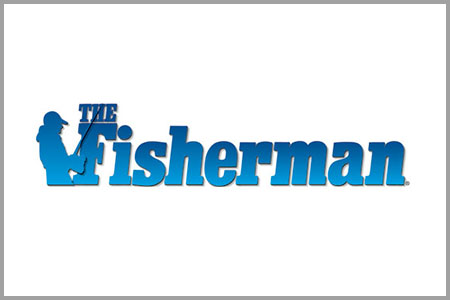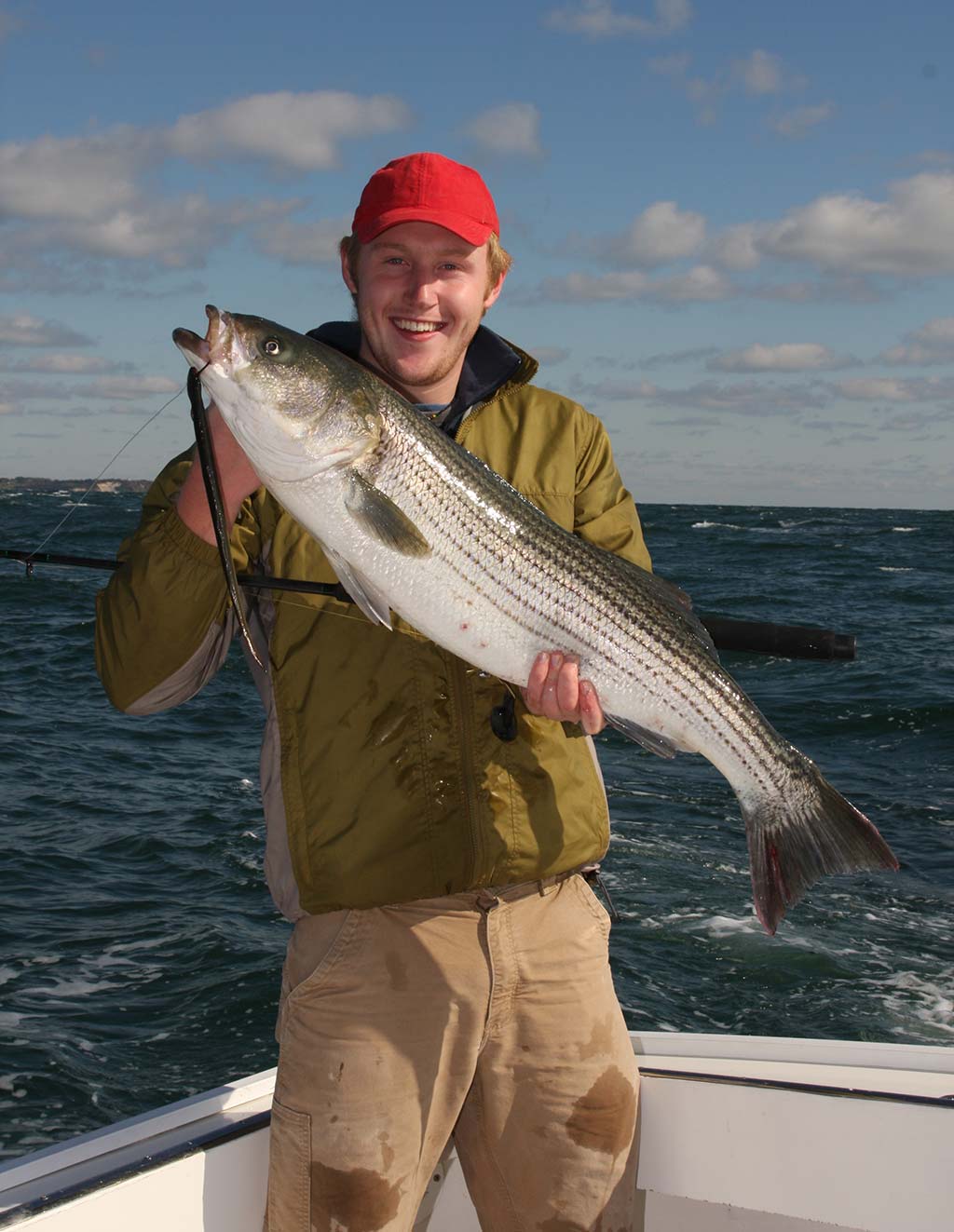
Here’s how to select the right hook for the job, including mandated circle hooks for stripers.
The Oxford English Dictionary discovered the first use of “101” as an introductory course number in a 1929 University of Buffalo course catalog. Colleges and universities began to switch to the three-digit course-numbering system around this time. The “101” designation for a class of learning has all the basic principles and concepts that are expected in a particular field.
“Hooks 101” is everything you need to understand the basics of regular hooks and circle hooks – plus a lot more detail – to help you catch more fish next season.
Hook Sizes
The system for numbering hooks is counterintuitive. Small hooks range in size from 1-32, but they’re numbered “backwards,” meaning, “32” is smallest and “1” is the largest. Medium to large hooks are labeled with an “0” (pronounced “aught”) appearing after each number, such as 1/0, 2/0, 3/0, and up to 27/0. These progress in “correct” numerical sizing, meaning, “1/0” is the smallest and “27/0” is the largest, with 1/0 being at the midpoint of the scale; thus, a size 6 hook is 10 times smaller than a size 6/0 hook. Sizes 20/0 to 27/0 are massive and intended for giant predators like tuna, swordfish, and sharks. They can range in price from $20 to a staggering $210 each. Still confused? A quick Google search for “fishing hook chart” will provide many graphic sizing and numbering images.
A hook’s shape determines its size, which causes hook dimensions to vary. The size of the hook is measured by a hook’s gap, which is the distance between the point and the shaft. Another key dimension is its throat or bite, which is the area between the point and hook bend. Hooks with larger dimensions in gap and throat create deeper penetration of the point and better holding power because the weight of the fish rides higher on the center of the hook’s bend.
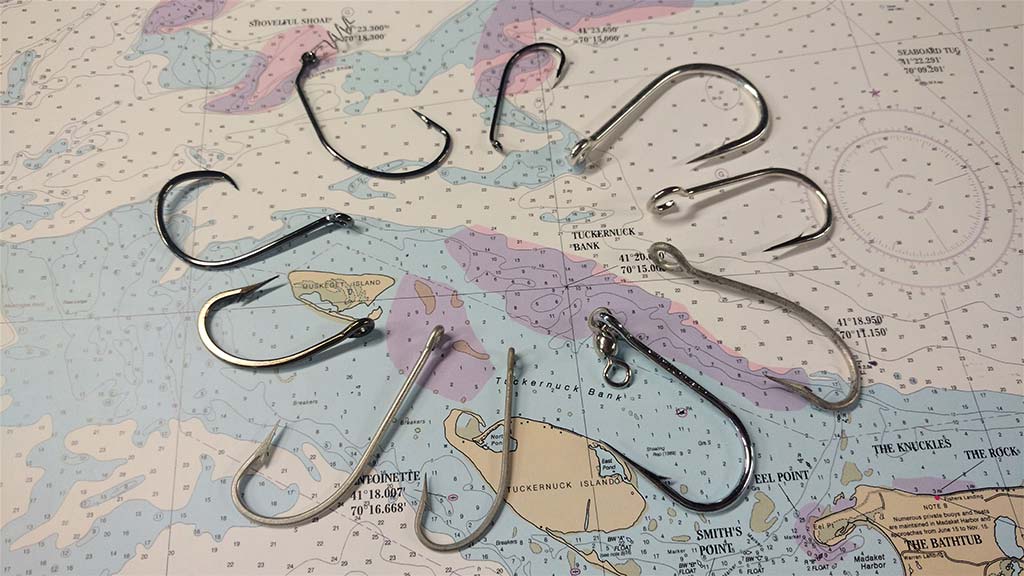
Super Hooks & Strength
In recent years, newly designed “super hooks” have entered the tackle market. They’re produced by all the leading manufacturers, and these hooks are available in a great range of styles to meet the needs of every species with professional-grade construction and performance. Top anglers routinely change out the hooks that come “factory standard” on their lures with super hooks.
“My go-to super hook preference,” says Capt. Ned Kittredge, a retired pro out of southern Massachusetts with 30 years of chartering experience, “is the Owner America brand. I prefer their ST-66 4X-strong tinned hooks as they are incredibly sharp right out of the package. I’ve lost many large fish because I didn’t bother to swap out hooks. I have vivid memories of 40-plus-inch bass straightening the hooks on expensive topwater plugs because, presumably, the manufacturer never ‘intended’ that lure to be used on big fish!”
“VMC trebles do a very good job for less money, and the slightly longer shank and thinner gauge wire performs well, especially for striped bass, bluefish, and false albacore. In fact, because of the weight difference, they have minimal impact on lure action. For the most powerful fish like tuna, however, it’s the Owner ST-66 treble all the time, regardless of hook size.”
With the introduction of high-tech coatings, ultra-sharp cutting points, innovative design, and extreme-strength ratings (like, “2X to 4X strong”), they’re also more expensive than the old-time classics, the latter of which are still on the market. But for the additional cost of super hooks, you’ll almost instantly notice a difference.
“Terminal tackle,” says Rich Haigh, a saltwater expert from southwest Connecticut with 45 years of experience, “is the single most important investment to catch fish, and it’s frequently ignored or overlooked. Anglers spend many thousands of dollars on boats, motors, rods, reels, and electronics, only to shortcut their terminal tackle. Many hook manufacturers cater to the budget-minded and entry-level consumer by producing cheap hooks to lower costs and boost sales—both for individual hooks and those rigged on lures. The low-quality hooks have lower tensile strength and less sharpness. That equates to reduced hook ups—and worse—hook failure on big fish.”
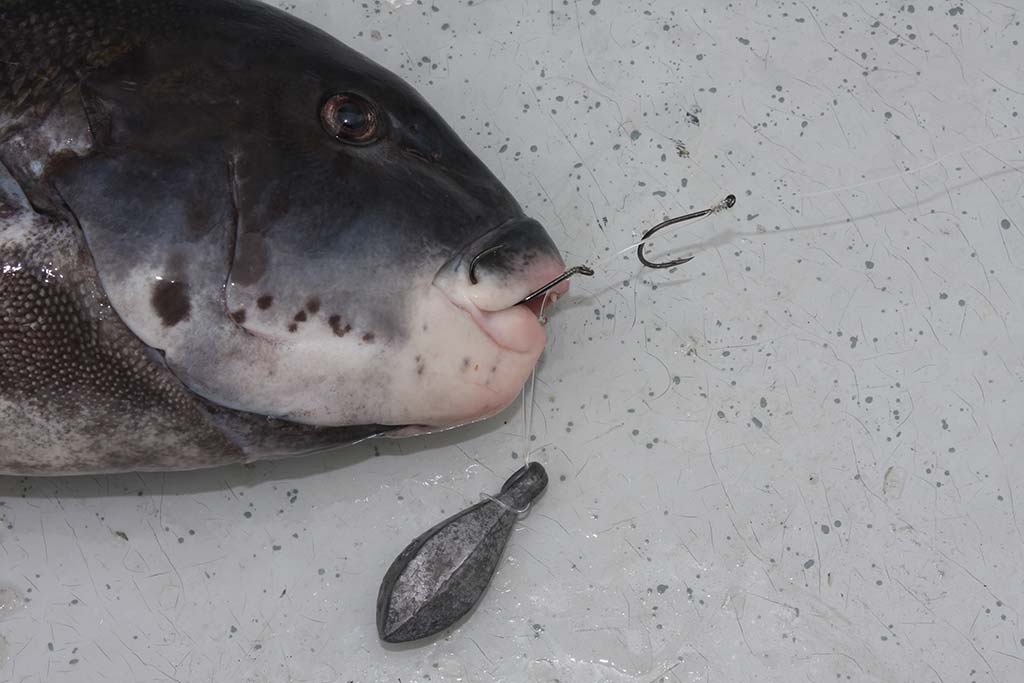
Points
Sharpness depends on the type of hook point and how it’s achieved in production. Some hooks have cutting-edge or spade-shape points, but all hooks have tradeoffs. Such a cutting point grabs quickly and penetrates tough jaws because the cutting edges slice though the toughest part of the mouth for a deep and solid hook set. The potential tradeoff is that the hook leaves a bigger hole in fleshier parts of the mouth, which could cause the hook to slide out during vigorous head shakes. However, they are precision-designed to create the smallest hole possible, so the incision can repair more quickly for released fish.
Conversely, conical tip or needle-point hooks create smaller holes, and in some cases may hold better than cutting-point hooks. So, you may opt for cutting points for rugged jaws like those of blackfish and bluefish but needle points for soft mouths like fluke or weakfish.
You can reasonably determine how sharp a hook is by placing the point on your thumbnail and pulling it across. If it slides on your nail, it’s not sharp. The more the point grabs or “bites” the sharper it is. Whether used on lures or with bait, super-sharp hooks can very easily penetrate a finger or hand with little pressure—even circle hooks—so use extreme caution when unhooking strong or feisty fish.
Hook Types
The market is saturated with hundreds of variations of hooks. Just the shape alone can vary widely with different types of curves, bends, shank length, point lengths, and eye positions. Here is a 101 snapshot of some of the most popular hook types:
Barbed or Barbless
Most fishing hooks have a barb, but some are available barbless (or you can easily crush the barb with pliers), often in the same style and size as barbed and denoted “BL.” A barbless hook is more fish-friendly, and hook removal is less stressful on the fish and the angler. They’re also extremely beneficial if the angler hooks himself (or someone else) because it means self-removal rather than removal by a doctor. Of course, it’s also easier to lose fish during a fight with a barbless hook, especially for novices.
Treble
Many of us know that treble hooks consist of three hooks stemming from a single shank. Trebles are primarily used with diamond-style vertical jigs and casting lures like plugs and jerkbaits. Trebles grab and hold fish better than single hooks, but are therefore more difficult to unhook. They also lead to greater harm to fish when used with bait. When deep jigging, they snag bottom more easily. Use extreme caution (for personal safety) when handling a fish caught on a lure featuring multiple trebles, as it’s easy for a flopping fish to stick you with a free-swinging hook.
Baitholder
Baitholder hooks are specially designed for holding soft bait such as sandworms, shrimp, squid, and baitfish pieces. This hook style usually features a long shank, a down-turned eye (for snelling), and a chemically-sharpened point to effortlessly skewer bait. They often have two or three reverse barbs on the rear of the shank to help hold baits in place higher on the hook shank.
Jig Hook
Jig hooks typically have a 90-degree bend, a round offset eye, and a razor-sharp point with a barb. They’re available in various styles like wide-gap jig, weedless, flipping, heavy wire, and light wire. They’re equally popular in freshwater and saltwater applications. The jig usually consists of a colorful lead head with the hook molded into it, and the hook shank is usually covered by body material like a skirt, bucktail, or soft plastic.
J Hook
A J hook is the most familiar, versatile, classic, and common hook style; and it’s shaped like its name. You can use J hooks in almost any fishing application, and the long shank allows for easier unhooking because there’s more available leverage. The quintessential J hook is called an O’Shaughnessy. Siwash are popular J hooks for bait and lures, too, but they feature heavier wire, a longer point and a shorter shank.
Octopus
Octopus hooks look like a modified circle hook. They’re available in both traditional and circle hook styles. Primary distinguishing differences from a circle hook are the eye of an octopus hook bends backward, and the hook has a more tapered and narrow point. Octopus hooks are used primarily for baitfishing when minimal hook weight and size are essential for a natural presentation, and have become one of the hottest hooks for blackfish. Like circle hooks, they’re sometimes difficult to unhook from a fish due to a short shank. Owner and Gamakatsu make particularly sharp octopus hooks.
Circle
Circle hooks—now one of the most important hooks in our arsenal—feature a point with a pronounced curve inward toward the shank—much more so than an octopus-style hook. They’re designed to slide out of a fish’s throat, roll, and grab in the corner of the mouth, which is critically important to catch-and-release fishing.
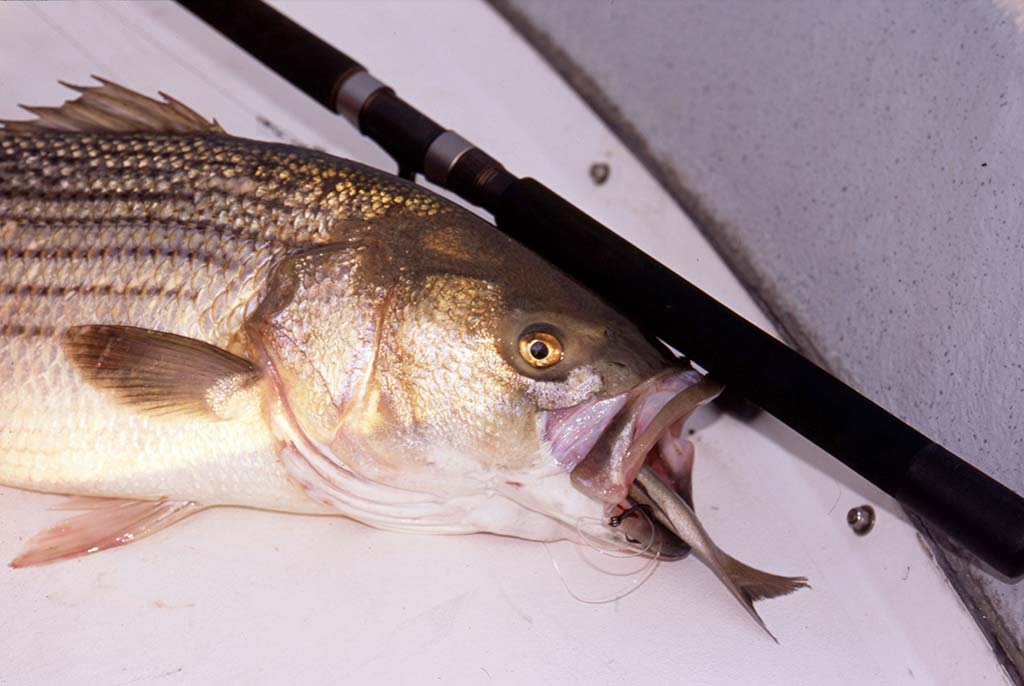
Lines & Circles
As you’ve likely heard, a recent mandate requires the use of circle hooks by all recreational anglers when targeting striped bass with any type of live, cut, or dead bait. There are no circle-hook exemptions for gear type or user groups; therefore, this regulation includes shore-bound, private-boat, and charter/head-boat anglers. So, if you haven’t used circle hooks before, now is the time to learn.
The size of the circle hook for striped bass bait rigs depends on the size and type of the bait. For large baits, like live menhaden, porgies, or hickory shad, an 8/0 or 9/0 circle hook is ideal. For chunk baits, whole squid, and live eels, a smaller circle hook like a 6/0 or 7/0 works well. When jumbo black sea bass mix with schoolie stripers, rig baits like sandworms, cut squid, small bait chunks, or clams on 2/0 to 4/0 circle hooks.
Upon detecting a strike, anglers new to circle-hook fishing must learn to set a circle hook gradually to prevent it from sliding out a fish’s mouth before the hook lodges in the jaw. Hook-setting advice from the pros is to just continue reeling without setting back hard with the rod as one would normally do.
“When using circle hooks,” says Capt. Chris Elser, a pro with over 40 years of experience along southern New England (ct-fishing.com), “it’s important to tighten down on the strike only by reeling the line tight. Do not lift up on the rod and use a strong hook-set as with traditional J hooks. Using circle hooks properly ensures that the fish is hooked in the corner of the mouth and can be released unharmed. For optimum success, circle hooks should be snelled; otherwise, they may not orient correctly in relation to the pull of the line and you’ll miss hookups.”
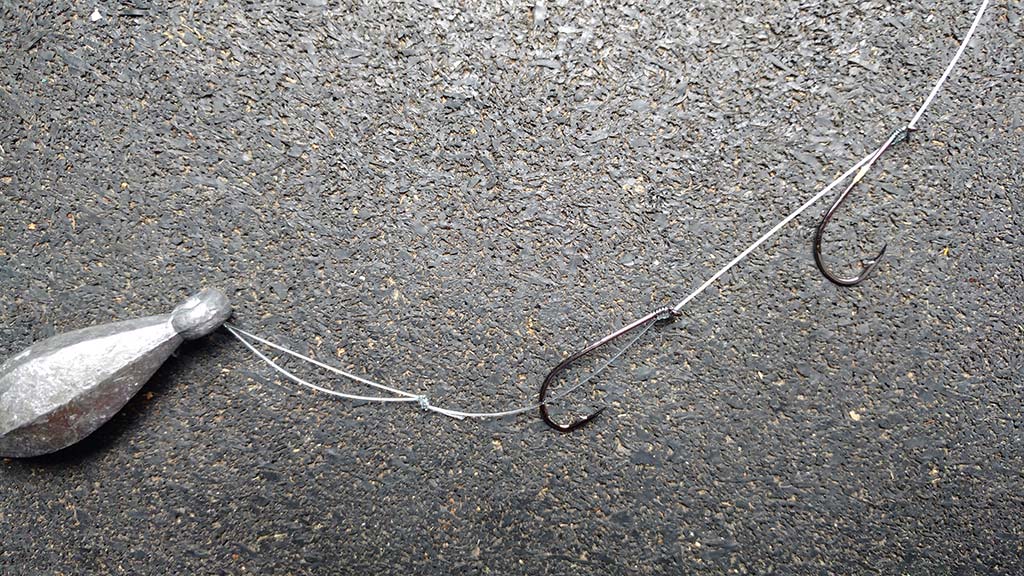
Chunking Stripers
Capt. Elser has fished all types of bait. When chunking for stripers or slammer blues, he cuts bunker, hickory shad, or porgies into three or four sections. “I prefer the body parts when targeting bluefish,” he says, “and the heads for striped bass. I pierce the circle hook through the top of a chunk leaving plenty of hook gap showing. It doesn’t need to be completely hidden. Never embed the entire hook in the chunk because you’ll miss the bite. I recommend cutting pieces about 2 inches wide, and fresh is always best.”
Experts prefer head baits for striped bass for several reasons: First, stripers often hang beneath schools of marauding bluefish and gobble leftovers—usually baitfish heads—as they drift to the bottom. Second, stripers swallow their prey headfirst, so the head makes sense as a natural enticement. Third, using heads will reduce annoying hook-ups from small bluefish or “rats” in the 2- to 5-pound class. Last, crabs can clean a body chunk quickly; they’re much less apt to destroy a head bait.
Choosing the right hook will help you land more fish next season. And using circle hooks when targeting bluefish and striped bass with bait will help protect those dwindling and valuable species.
